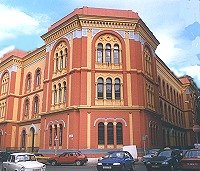Gush Halav: Home to the Maronites
Despite 14 centuries of persecution, these Galilee-based Christian followers of a hermit named Mar Maroun have refused to abandon their faith. Sound familiar?
While browsing the Internet for information on the Galilee town of Gush Halav, we found these words on a site linked to the Ministry of Tourism: “The Arab village of Gush Halav is situated in Israel’s Galilee area. . .” This was repeated by the usually reliable Jewish Virtual Library, and any number of other sources.
But within minutes of entering Gush Halav in preparation for this article, we learned — and not for the first time — that the Internet can be wrong! For, according to our host, Shadi Khalloul, the vast majority of Gush Halav residents are not Arabs at all, but Maronites: Christians who have been followers of a hermit known as Mar Maroun since the end of the 4th century. And even though you often hear Israelis calling it by its Arabic name “Jish,” Khalloul asked us to please not refer to Gush Halav as an Arab village!
Get The Times of Israel’s Daily Edition by email
and never miss our top stories FREE SIGN UP!
Khalloul explained that like Father Abraham, the Maronites originated in Aram (an enormous area stretching from Mesopotamia to the Mediterranean Sea). Over time, they dispersed throughout the Middle East. When the Arabs swooped into the region early in the 7th century, they tried to force Islam on the Aramaen population in general and the Maronites in particular. Yet despite immense pressure, the Maronites, like the Jews, refused to abandon their faith. Since then, Aramaen Maronites have been continually persecuted by the Arabs. Most of the area’s Maronites eventually moved for safety into the Lebanese mountains, where they tilled the rocky hills. Thousands were killed in a bloodbath that took place in the mountains in 1860.
Historically, and again, like the Jews, the Maronites spoke Aramaic. Today, although the prayers are written in Aramaic, only the elders of the region and a few scattered communities in Cyprus and Lebanon still speak what was once the lingua franca of the Middle East. A few years ago, Khalloul began working towards its revival as one way of re-connecting the population with its heritage. As highly motivated as any Jewish pioneer, and as passionate about Aramaic as Eliezer Ben Yehuda was about Hebrew, Khalloul managed to get the ancient tongue into the village curriculum: Aramaic is now offered to all pupils from first to eighth grade.
Israel’s 7,000 or so Maronites have never raised a finger against the Jews, not before, during, or after the War of Independence. Nevertheless, during that war they were told to leave their homes in the Aramaen Maronite village of Bir’am (near Kibbutz Bar-Am), and promised a speedy return. Most of them resettled “temporarily” in Gush Halav, but five years after the evacuation, and despite a court decision in their favor, Bir’am was razed to the ground. “Temporary” became “permanent!”
Although their young people identify with, and are loyal to, the Jewish State, they are not required to serve in the army. Nevertheless, after they finish high school almost every graduate volunteers for either the army or National Service. Khalloul himself volunteered for the Paratroop Brigade and reports at least once a year for reserve duty.
Although Khalloul’s day job is in hi-tech, he spends every spare moment promoting tourism to the village. And no wonder: located on the slopes of Mount Meron in the Upper Galilee, Gush Halav faces stunning views from almost any vantage point and features old and new churches, Jewish antiquities, direct access to a perennially flowing river, and a hidden lake. The latest attraction: a wheelchair-accessible path from the village to nearby Moshav Dalton — two-and-a-half kilometers long each way.
Neither Eastern Orthodox nor elaborately Catholic, the older of the village’s two Maronite churches is surprising in its simplicity and looks, for all the world likes the interior of a cave! Khalloul told us that in the 5thcentury, about a hundred years after the Byzantine Empire had accepted Christianity as its official religion, a deeply spiritual priest named Maroun decided to meditate in solitude within the mountains of Mesopotamia (today’s northern Syria). His saintly life attracted many followers, called Maronites, who accepted the authority of Rome as Catholics who worshipped in their native tongue. Maronites are the only Eastern Christian sect that is not split between Orthodox and Catholics: all Maronites are Catholic.
Because of the Arab invaders’ consistent persecution of the Maronites, they had to be ready at all times for flight. As a result, they often worshipped in simple structures that could be quickly abandoned, which is why the older of the villages’ two churches has such a unique character.
On the other hand, the modern Maronite Church is absolutely stunning. Completed in 1995 and built with funds raised among Maronites here and abroad, the church can hold 1,000 people and on holidays like Easter and Christmas it is full to bursting.
While the décor is simple and even the pillars are plain, the walls are colored in warm and comforting shades of orange, yellow, and peach. On the windows, and sandwiched between views of the Way of the Cross, are lovely Old Testament scenes from Creation to the Revelation on Mount Sinai.
Besides two lovely churches and its unique village atmosphere, Gush Halav is known for the stunning riverbed next door. A walk to the riverbed, called Nahal Gush Halav, is absolutely delightful, with its views of sheer white cliffs, a plethora of wildflowers, and several tiny waterfalls. Since the river flows all year round, people flock here in late summer to enjoy both the cooling water and the wild raspberries that grow nearby.
During the Second Temple period, and in the centuries following the Great Revolt against Rome (66-73 C.E.), Gush Halav was a thriving Jewish village. Yohanan Ben Levy, a famous Jewish warrior, was born in the village. Better known as “Yohanan from Gush Halav,” he was one of the main figures leading the fight against the Romans during the revolt. After the Golan Heights and the rest of the Galilee fell to the Romans, the conquering army laid siege to Gush Halav. When it became clear that the town could not survive, Yohanan escaped to Jerusalem (where an alley bears his name) and continued the good fight inside the Holy City.
Considering the long-term Jewish presence in Gush Halav, it is not surprising that it sustained at least two synagogues. The ruins of one were incorporated into the foundations of a Greek Orthodox church perched at the very top of Gush Halav. The other is right along the riverbed path, on the slopes inside an olive grove.
The lintel on this synagogue, which functioned from the 4th century to the 6th, boasted a sculpted eagle — a decoration found all over synagogues in the Galilee and Golan Heights. Also at the site: a column with barely decipherable letters that read, in Aramaic: “Yosa Ben Nahum made this. May he be blessed.”
Not far away, a shiny lake is almost completely hidden within the folds of the neighboring hills. While trying to find it on our own, we got lost. So we stopped at a field and asked an elderly shepherd, in our second-year Arabic, where to go next. His bronze face was creased from the sun. In answer to our query, the shepherd gave us precise directions, in perfect Hebrew. We ended our time in Gush Halav at a clear blue lake, surrounded by flowers and horses, enveloped in a pastoral tranquility that stayed with us for days.
The season for picking fruit begins in May, and in June Gush Halav will be holding a festival with Aramean music, food, tours and all kinds of goodies. See www.aramaic-center.com, and/or contact Khalloul for information about guided tours, overnights, and activities in the village: [email protected].
—————————————————————————————————–
Shmuel Bar-Am is a private tour guide.




















